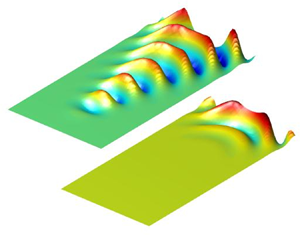Published online by Cambridge University Press: 23 December 2020

Instability to Tollmien–Schlichting waves is one of the primary routes to transition to turbulence for two-dimensional boundary layers in quiet disturbance environments. Cancellation of Tollmien–Schlichting waves using surface heating was first demonstrated in the experiments of Liepmann et al. (J. Fluid Mech., vol. 118, 1982, pp. 187–200) and Liepmann & Nosenchuck (J. Fluid Mech., vol. 118, 1982, pp. 201–204). Here we consider a similar theoretical formulation that includes the effects of localised (unsteady) wall heating/cooling. The resulting problem is closely related to that of Terent'ev (Prikl. Mat. Mekh., vol. 45, 1981, pp. 1049–1055; Prikl. Mat. Mekh., vol. 48, 1984, pp. 264–272) on the generation of Tollmien–Schlichting waves by a vibrating ribbon, but with thermal effects. The nonlinear receptivity problem based on triple-deck scales is formulated and the linearised version solved both analytically as well as numerically. The most significant result is that the wall heating/cooling function can be chosen such that there is no pressure response to the disturbance, meaning there is no generation of Tollmien–Schlichting waves. Numerical calculations substantiate this with an approximation based on the exact analytical result. Previous numerical studies of the unsteady triple-deck equations have shown difficulties in capturing the convective wave packet that develops in the initial-value problem and we show that these arise from the choice of time steps as well as the range of the Fourier modes taken.
Present address: Mathematical Institute, University of Oxford, Oxford OX2 6GG, UK.